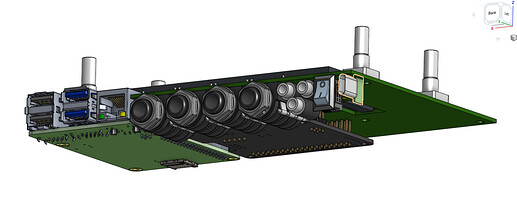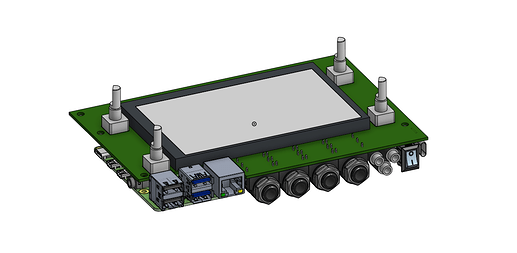Happy  'cause it was such a pain to source them.
'cause it was such a pain to source them.
Might get a performance edge with an SSD in the PCI slot.
One potential advantage of the compute module is in making a pocket size Zytnthian, Here’s a matching size IO board design example.
Someone’s open source IO board design might be a labor saving jumping off point for a Zynthian specific IO board design.
From Digikey (maker.io) Creating a Raspberry Pi Compute Module 4 (CM4) Carrier Board in KiCad
Seeedstudio.com (who offers board production services), had an article in Nov. 2010 (when the official IO board may have been the only candidate)
How to customized CM4IO (Compute Module 4 IO Board) board using kiCad?
(One comment “It seems that the RPI organization closes the full files sharing…so sad…” there is a waybackmachine file archive noted)
Article on a carrier hack using a router on a single side blank copper board. (very limited potential)
I would love to see a PCB designed that has audio and other required features to act as a parent for a compute module. Maybe Zynthian 5 will use such a form factor. It could reduce the amount of interconnects making construction simpler and may allow for a smaller / lower profile design. Having combination XLR connectors on the back for audio with MIDI and proper power connector would be great. Such a parent board could have power management, etc. Who knows what is going on at the Zynthian labs…
I also wonder if Raspberry Pi Foundation are considering replacing the Broadcom SoC with their own silicon. There have been no indications of this but following the development of the simpler microcontroller for their Pico one might hope they have aspirations in that direction. Now that they have proven they can achieve their own silicon design it feels like a natural progression and final step to fully open hardware. Of course that may necessitate considerable change for projects that might be using code written for the old SoC.
Seeing how Eben Upton, technical director and ASIC architect for Broadcom – founded the Raspberry Pi Foundation, it seems unlikely that the Broadcom relationship would change.
Someone like Apple is in a better position to engineer an SOC, an article on the shift to M1 Arm based SOCs in lap/desktops, suggested that Intel’s design is floundering, and the airline 100 watt laptop battery limit dictates more power efficiency to allow continued performance improvements.
It’s suggested that disappointing 64 bit Arm code performance issues might now get more attention.
hardkernel.com (South Korea) Odroid boards use a Samsung SOC.
The ARM® big.LITTLE Octa core processor, used on their top model resembles the Apple approach with a mix of low and higher power cores.
I would love to see a PCB designed that has audio and other required features to act as a parent for a compute module. Maybe Zynthian 5 will use such a form factor. It could reduce the amount of interconnects making construction simpler and may allow for a smaller / lower profile design. Having combination XLR connectors on the back for audio with MIDI and proper power connector would be great. Such a parent board could have power management, etc. Who knows what is going on at the Zynthian labs…
I am working on something exactly like what you said, except It uses hifiberry as a blug-in board.
I think compute module is not the best option because while it’s very thin, for example XLR connectors are already as thick as the RPI, while making it harder to source and design around, with a lot of IO missing that we do use. A good example of such a itegrated DAC+controllers+screen board for rpi is this one
I was also thinking of adding a normal dc barrel power connector from 9v to 12v and an internal battery. Here are some pics of the thing in process
It uses a 5 inch capacitive screen from aliexpress the rest is more or less the same as in the original zynthian.
Adding the DAC-ADC circuit is something I would like to do, but can’t really figure out as of right now (collabotation is welcome of course!) it’s a kicad proyect so i could set up a repo, the final idea being to release this as open hardware with CC license.
Hi, interesting.
One big problem I see in your design is RBPi4 cooling
I’ve got also a couple of “design” in my basket (but now I’m at work …).
One PCB is quiet finished with a built in codec (the famous wm8731) HP, line OUT, line IN, MIDI, mcp23017, encoders and switches and power supply.
Héhé that’s more or less my goal but the process will be very looong (I’m not as efficient as you are in programming stepsequencer !!!).
Compute module is incredibly small, these Hirose connectors are so thin, that is challenging.
This is really the big improvement imho.
Some inspiration:
- Ctag-face: with AD1938 codec (4in, 8out), driver is in linux kernel and there is a device tree overlay for the beagle bone black in the Ctag-face repository
- uCodec: with AD1939 codec (mostly the same as AD1938)
- superaudioboard: with CS4272 codec (2in, 2out), that board has a RBPI overlay.
- pedalevite: with CS4272 codec
=> these two CS4272 projects are really advanced … - some designs with CS42448: 6in, 8out, that chip is used in AudioInjector Octo, so it “should” be supported by the RBPi
- i2S_audio_phat: with wm8731 codec (2in,2out + HP out)
One big problem I see in your design is RBPi4 cooling
The idea for this is to use a metal case and the same approach as the current one with the official zynthian.
I’ve got also a couple of “design” in my basket (but now I’m at work …).
One PCB is quiet finished with a built in codec (the famous wm8731) HP, line OUT, line IN, MIDI, mcp23017, encoders and switches and power supply.
Nice! maybe we could join forces and get something out the door? I am willing to fund the research (at least the prototyping stage) as i was gonna do that anyway. for thow in my designs the HifiBerry is stacked onto the board, but it would be amazing to do away with it (with the reduction in costs that allows for) without losing the balanced Ins and Outs.
This is really the big improvement imho.
Is the PCI slot exposed in the normal pinout of the RPI4?
For low cost and board space budgets the WM8731 “consumer product” codec chip used on the low cost Audio injector boards might do.
The DAC THD+N (dB)-84 and ADC THD+N (dB)-76 while not state of the art studio numbers, they look good compare to the analog synth day numbers.
(The $16.90 from Amazon Pi Zero format Audio Injector may fit on that little CM4Ext_Nano board without hanging out too much.
Bucket Brigade Units … ![]()



